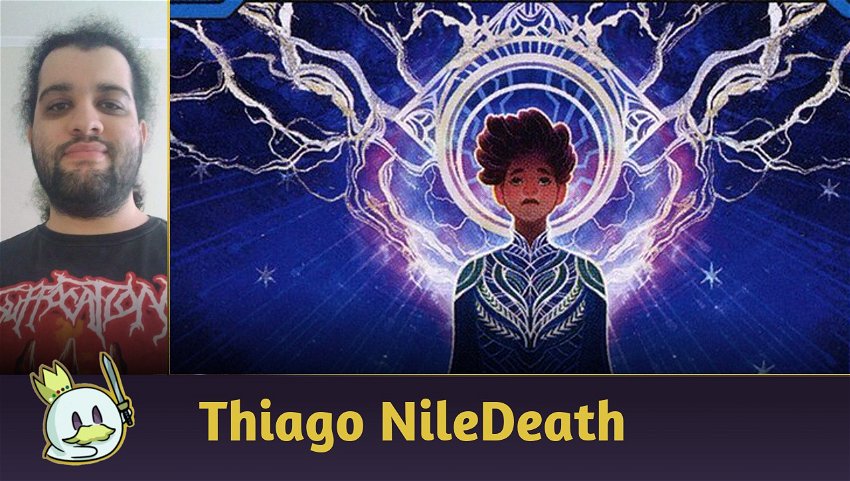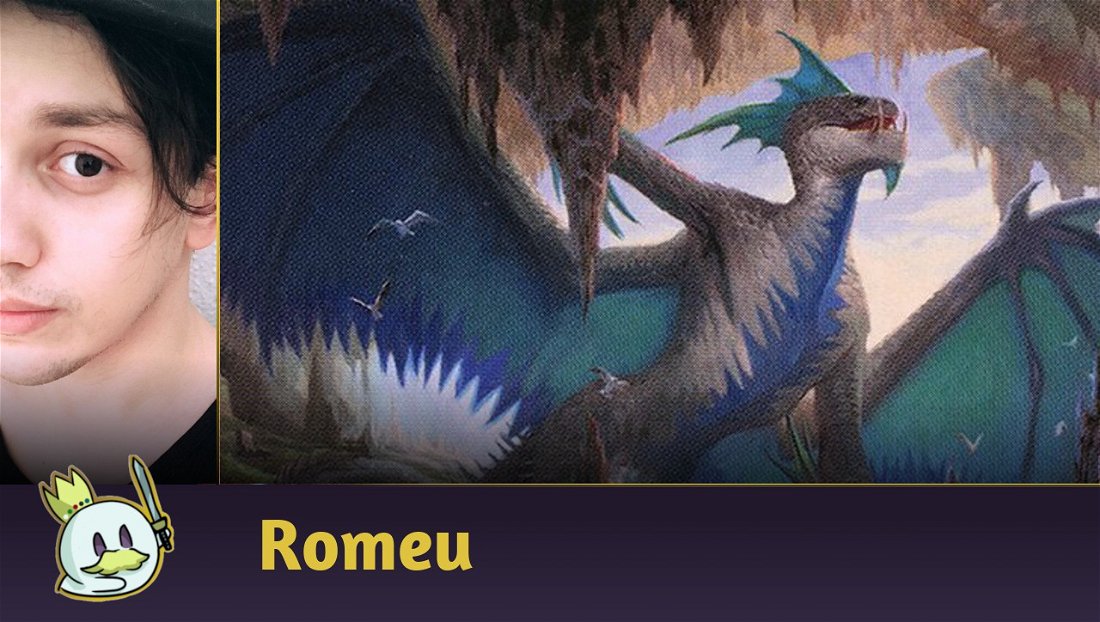To end 2021 with a flourish, let's talk a bit about Historic and what happened, most importantly, how the sets impacted Arena's eternal digital format. If you are a player of another format, I also made a retrospective of Standard in 2021.
First, the focus of the article is best-of-three, as there are no relevant best-of-one tournaments other than day 1 of the Arena Open. Another detail is that, when I talk about bans in the format, I consider that the card has been banned since its suspension in Historic, since, deep down, it's the same thing, we've never seen a suspended card that wasn't banned some time later, only Burning-Tree Emissary. I won't talk about Historic Brawl either because that's not the format in question, we can talk about that in another article, if readers want me to.
Ad
Historic before Kaldheim
Quickly recapping what happened before Kaldheim, we had the dominant Sultai Midramp with the supreme trinity of Uro, Titan of Nature's Wrath, Nissa, Who Shakes the World and Hydroid Krasis as highlights of the best deck.
Over time, some techs like Doom Whisperer and Lochmere Serpent have been added to some lists to gain mirror matchs. Another card that stood out was Scavenging Ooze, great for dealing with the opponent's graveyard and against aggressive decks, such as the Mono-Red Goblins, which was worrisome, as it was still used for having the lottery card Muxus, Goblin Grandee that can simply ignore everything that happened in the game so far and deal 200 damage out of nowhere.
The main deck to beat Sultai was the Rakdos Sacrifice which featured Mayhem Devil, Cauldron Familiar and Witch's Oven to deal heavy damage over turns and close the game. With its solid base, the archetype was able to rush the Sultai if necessary, but also played the long game, especially with Claim the Firstborn stealing a giant Uro or Krasis for lethal.
The Rakdos Arcanist was a relevant deck at the time, but it wasn't as good against aggro and random decks of the format.
Kaldheim and Historic Anthology IV
Kaldheim didn't make much of an initial impact on the format, although we're starting to see more aggressive monocolored decks utilizing the snow manabase for Faceless Haven.
However, shortly thereafter we had the banning of Uro and Omnath, Locus of Creation, entirely changing the format. From there, Jund Food and Jund Citadel took over Historic, some controls like Azorius and Bant stood out and decks with Collected Company, another card that has the potential to ignore everything that happened in play until then and win. Along these lines, Selesnya Angels was created with the latest additions of Righteous Valkyrie and Youthful Valkyrie and Gruul has returned to prominence.
The first 2021 Anthology brought some good cards, like Thraben Inspector and Declaration in Stone for Mono-White and Coldsteel Heart which was used in 5 colors Niv-Mizzet. However, like all the other Anthologies, its impact was low on the format.
Strixhaven
Briefly talking about Strixhaven, we had two Staples, Expressive Iteration and Elite Spellbinder. Another card that is widely used today, but it took us a while to realize its strength is Go Blank. Similar in purpose to Standard, it's great for exiling graveyards and still discarding your opponent's hand.
Mystical Archives & Historic Anthology V
Mystical Archives brought very powerful cards, including cards banned in other formats.
I couldn't help but start with the format's Tier 0, the Dimir Tanted Pact which combined Tainted Pact and Thassa’s Oracle to win by having zero cards on the library

After the Oracle's quick ban in May, we had another tier 0, the Jeskai Turns.
Ad
The deck was totally dominant until Time Warp, a problematic card that went into the format with the ban alert, was banned. With Mizzix's Mastery, a five mana extra turn that was not exiled, Magma Opus and Velomachus Lorehold, the deck quickly became the best with a lot of consistency thanks to Brainstorm, another banned card, and Expressive Iteration, staple of virtually every Magic format.

Then we had another ban, Time Warp in June, and we continued to see the prevalence of blue decks with Brainstorm and Memory Lapse. This time Jeskai was another deck with Magma Opus, Mizzix’s and Torrential Gearhulk to get back the eight-mana instant from the graveyard. But the deck's main “brokenness” was discarding Opus in turn 2 to generate a treasure token and returning in turn 3 by casting Opus with Mizzix and often making it impossible for the opponent to come back to the game.
Another significant card was Lightning Helix, the card that killed the format's aggros for a few months until Historic Horizons was released.
Izzet Phoenix, an archetype known in Pioneer and Modern, appeared in Historic from the Mystic Archive and since then, it has been widely played in tournaments and ranked, obtaining good results. Faithless Looting does a fantastic job of finding copies of Arclight Phoenix in the deck and leaving them in the graveyard to come back on turn 3 attacking.

Looting was (and still is) an essential card in many strategies, like Dragonstorm, some Rakdos and, more recently, Mono Red Discard. The card changed Historic's dynamic by enabling the existence of Izzet Phoenix.
Before you ask me, “but what about Kozilek?”. Well, Inquisition of Kozilek also had a big impact on the format and plays on all black decks, whether it's Arcanist, Jund Food, Sacrifices, Mono Black Aggro, Dimir Control and Dimir Rogues. The only reason I haven't given these decks much space so far is because almost half of the year was dominated by some Jeskai or other blue decks, such as Tainted Pact.
Anthology V had a more discreet but relevant impact. Kolaghan's Command is widely played in Rakdos to this day. Dromoka's Command usually sees play on the sideboard of Selesnya Humans or Selesnya Midrange, which was one of the main decks until Jumpstart.
The base of these Selesnya decks allowed them to beat controls with Thalia and Elite Spellbinder (in addition to Company) and aggros with insurmountable creatures, such as Lovestruck Beast and Yasharn, Implacable Earth.
Relic of Progenitus saw some play in some decks as graveyard hate and Dragonstorm, although not very consistent and efficient, is a dangerous deck when there are no such graveyard hates.
For the third month in a row we had a ban, this time it was Brainstorm the card chosen in July to leave the format. As stated earlier, Jeskai's strategy was extremely consistent and strong against virtually all decks, and Brainstorm was the main consistency piece along with Iteration. Brainstorm deformed the format so much that there was even a Temur Creativity that used Indomitable Creativity to search for Koma, Cosmos Serpent and had good results in tournaments. Basically, it was wrong to play without blue in the deck if you wanted to win because the Brainstorm + Lapse + Iteration kit was very consistent and strong.
Ad
Jumpstart: Historic Horizons & Innistrad
We come to the main part of the article, the set with the most cards in Arena's history, bringing with it many cards from Modern Horizons I and II, as well as other digital-only cards such as Davriel, Soul Broker. Since there's a lot of possible content on Jumpstart, I'm going to focus on the top cards that created archetypes and new decks that did well in tournaments and ranked.
The Jumpstart metagame wasn't isolated from Innistrad: Midnight Hunt for very long, so I found it feasible and convenient to write about the two at the same time, as there was approximately a month between the launch of these sets. Innistrad: Crimson Vow
didn't bring significant changes to the format, so I think it's worth joining this same section, as few cards came to make existing decks more solid.
The first deck is Jeskai Creativity, yet another archetype with Creativity looking for an insane creature, this time Serra’s Emissary.

A creature that, upon entering the battlefield, has a secret ability to make aggressive decks concede, dominated the format for a few weeks until they figured out how to play against it.
2 cards with Delirium fit the format perfectly, playing in several strategies, Dragon's Rage Channeler and Unholy Heat. Channeler is known as the improved replacement for Delver of Secrets, and Heat deals no less than 6 damage to any creature or planeswalker for just 1 mana, demonstrating the full power creep potential of the last few years.
For red decks that use the graveyard, we also had Seasoned Pyromancer, a creature that generates card advantage when cast and when exiled by his activated ability, and Managorger Phoenix, a digital-only creature.
Jumpstart also brought an aggro-combo deck with Heliod, Sun-Crowned and Scurry Oak. The archetype has always beaten aggressive decks, but only recently has become more popular and is one of the main decks in Historic. With Prosperous Innkeeper serving as another source of life gain and ramping up with the treasure token, the deck became more and more consistent until it reached the Lunarch Veteran version, very much geared towards winning on turn 4.
White's aggressive decks have gained an important card advantage engine also known as the Control Destroyer: Esper Sentinel.
Adeline, Resplendent Cathar and Brutal Cathar are among Innistrad's cards that left the deck with the best top curve. Brutal Cathar is a similar removal to Skyclave Apparition, but synergistic with humans. Adeline, in addition to being strong on its own, generates a lot of advantage with Thalia's Lieutenant, which gains counters when the 1/1 human token enters the battlefield attacking. All of this is optimized by Collected Company, the 4 mana card that instantly turns games.
Ad
Jund Food was strengthened with The Meathook Massacre dealing more damage in the Cat + Oven combo and Ravenous Squirrel, the Modern Horizons one-drop that quickly spirals out of control. At this point, it is already known that the green and black food base is strong in Historic and flexible has an extremely flexible list. And precisely this malleability gave rise to a variation, Golgari Food, one of the best decks in the format today.
Not needing high-cost drops, the archetype runs Lurrus of the Dream-Den as a companion and causes sudden lethals with the squirrel and the various possibilities of sacrificing creatures and artifacts to place counters on it.
Taking advantage of this life of “combos” and sacrifices, one card that made a difference in Bolas's Citadel decks was Yawgmoth, Thran Physician. He, like Woe Strider, clears the top, so the Citadel can hit more relevant permanents to win the game. With Golgari Food on the rise, these decks are in the background for not being as efficient and consistent, but they always appear in the ranked.
At this point, it might be good to remember the ban on Memory Lapse in October, leaving Jeskai significantly worse and more vulnerable. However, Archmage’s Charm came to become a staple of the archetype for its versatility. Charm is the type of card we almost never take out when sideboarding because it is good in almost any situation and can draw cards or steal a one-drop or token, like a 15/15 squirrel or Shark Typhoon, or Commence the Endgame giants. Obviously, countering spells is always relevant as well.
I would like to briefly mention a few decks that are in the metagame to this day, doing well in tournaments, but never emerging.
The first of these is the Merfolks. With Shoreline Scout, a digital exclusive card, Merrow Reejerey and Svyelun of Sea and Sky, a deck once considered a meme has become very dangerous, being good against control and midrange.
The 5 colors Niv-Mizzet was never a tier 1, but it has been well positioned at times. Having many tools to hold the game against aggro and turn the game quickly with Niv-Mizzet Reborn. Yielding an advantage so big it has the secret text of “beat target aggro when resolved”.
It would be unfair to finish the article without even quoting the Orzhov Auras. The deck became tier when Jeskai dominated because it's good against decks with few unconditional removals, having discards and protections against sweepers. The reason I didn't name the deck earlier was because it received nothing or almost nothing in 2021 – without a doubt Inquisition of Kozilek was the most relevant card. Unfortunately, we didn't have any significant creatures for the deck or many strong interactions.
Alchemy
Finally, I'll talk a little about the digital cards and the rebalanced ones, all of which are legal in Historic.
So far, I haven't seen any minimally relevant impact of Alchemy in the other digital format, with the exception that a few less used cards are now abandoned and unplayable. Perhaps Key to the Archive is the only addition to the format. I like rebalancing cards, but not how it is done right now, where the same cards are rebalanced the same way in different formats.
Ad
Conclusion
And so, we come to the end of the 2021 Historic retrospective.
May 2022 bring a lot of fun new cards for us and that Wizards sees it as a priority to fix bugs and serious errors in Magic Arena, in addition to having spectator mode (I know it won't, but it doesn't hurt to dream).
Any questions, comments or feedback I'm available in the comments below. A happy new year to everyone!









— commentaires0
Soyez le premier à commenter